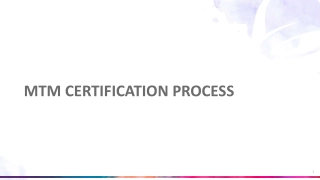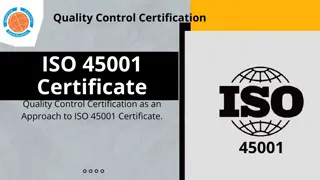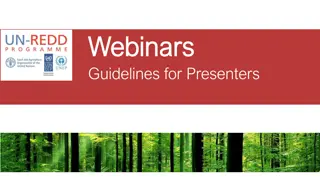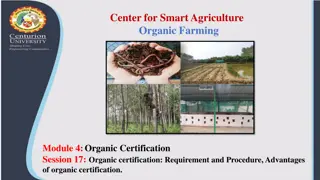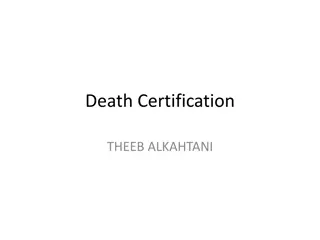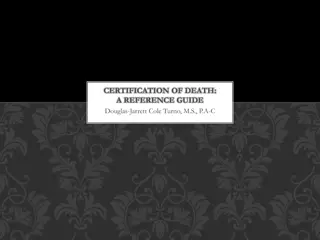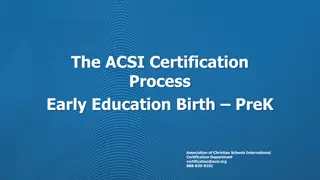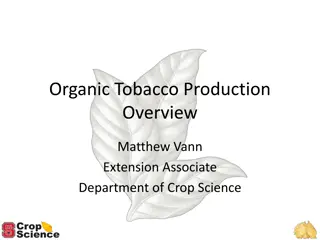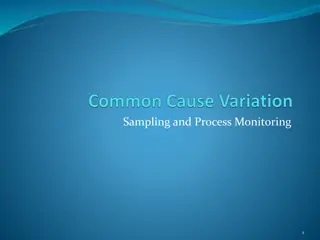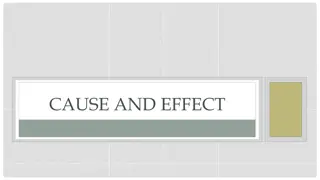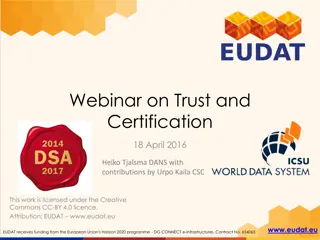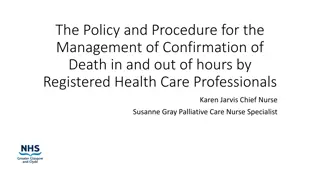
Cause of Death Webinar on Death Certification
Join the New York City Department of Health and Mental Hygiene for a webinar on the importance of cause of death certification and the proper reporting process. Learn about the various deaths clinicians certify and the jurisdiction of the Office of the Chief Medical Examiner.
Download Presentation

Please find below an Image/Link to download the presentation.
The content on the website is provided AS IS for your information and personal use only. It may not be sold, licensed, or shared on other websites without obtaining consent from the author. If you encounter any issues during the download, it is possible that the publisher has removed the file from their server.
You are allowed to download the files provided on this website for personal or commercial use, subject to the condition that they are used lawfully. All files are the property of their respective owners.
The content on the website is provided AS IS for your information and personal use only. It may not be sold, licensed, or shared on other websites without obtaining consent from the author.
E N D
Presentation Transcript
Cause of Death Webinar on Death Certification New York City Department of Health and Mental Hygiene Bureau of Vital Statistics This session should not be recorded.
Why is cause of death important? Public health programs and policies Clinical and population research Surveillance of outbreaks, pandemics and emergencies
What deaths do clinicians certify? The manner of death includes: Natural or External (accident, homicide, suicide or undetermined) Clinicians certify natural deaths, which are caused exclusively (100%) by disease. If an injury of any sort causes or contributes to death no matter how minor the contribution, the manner of death cannot be natural. You should consult with the Office of the Chief Medical Examiner (OCME) on these cases. nyc.gov/ocme, report a case For more resources, visit nyc.gov/ocme, search for and scroll to the bottom section titled "Training Resources to Improve Cause of Death Reporting."
Deaths that the OCME Certifies OCME has jurisdiction over deaths occurring under the following circumstances: Criminal violence or from an unlawful act or criminal neglect Accidents (such as motor vehicle, industrial, home or public place) Suicides Drug or chemical overdose or poisoning Sudden death of a person in apparent good health Deaths during diagnostic or therapeutic procedures or from complications of such procedures Deaths resulting from employment either due to disease, injury or toxic agents Deaths which occur in any suspicious or unusual manner For more information on New York City reportable deaths, visit nyc.gov/ocme and search for nyc.gov/ocme report a case.
Death Registration Process* Medical Certifier: Pronounces and certifies the cause of death within 24 hours of death Funeral Director or Facility: Signs within 72 hours of death Bureau of Vital Statistics: Approves registration Office of the Chief Medical Examiner: Reviews and approves any cases going for cremation *As mandated by the New York City Health Code 205.03 Reporting deaths. Available at www1.nyc.gov/assets/doh/downloads/pdf/about/healthcode/health-code-article205.pdf.
How to report cause of death? Include the chain of events that directly caused the death in Part I. Put the best estimate of the time interval between the onset of each condition and death. Include other significant conditions contributing to death in Part II.
How to report cause of death? Hours Immediate Cause When completing Part I, ask What was the final disease or condition that happened right before the patient s death? or What was the last condition I was intervening upon to prevent my patient from dying? Enter the answer to these questions, which is the immediate cause, on Line A.
How to report cause of death? Hours Immediate Cause Days Intermediate Cause Once you have identified the immediate cause, ask What disease or condition caused the condition in Line A? This is an intermediate cause. Enter this on Line B.
How to report cause of death? Hours Immediate Cause Days Intermediate Cause Months Intermediate Cause Similarly, for Line C, ask What disease or condition caused the condition in Line B?
How to report cause of death? Hours Immediate Cause Days Intermediate Cause Note: This might not be the admitting diagnosis but the condition that Intermediate Cause Months caused life-threatening complications that required hospitalization. Underlying Cause Ask questions until you determine the condition that is NOT the result of another condition. This is known as the underlying cause.
How to report cause of death? Hours Immediate Cause (Most recent condition) Days Intermediate Cause (An older condition) Part II contains one or more conditions or events that were not directly in the chain of events in Intermediate Cause (An even older condition) Months Part I but those that the medical provider feels contributed to the individual s death. Underlying Cause (The oldest start of the chain of events) Years Other significant conditions Source: Hanzlick R. Cause of Death and the Death Certificate. 2006.
How can eVital assist you? You must save the page in eVital. This will check for some NYC-specific reminders. Click Validate to run the information you entered through the CDC server to check for errors.
Possible Validation Errors: Acronyms and Misspellings Click the correct spelling from the drop-down list for the condition you intended.
Possible Validation Errors: Ill-defined or Ill-specified Conditions Death due to old age is rare; re-review the chart. Enter a specific primary organ site. Review the record and provide a more specific cause. For cancer deaths, specify the primary organ site whenever possible. For deaths of the elderly, do not specify old age. Try to determine a cause or pre-existing condition for the patient.
Possible eVital Reminders: Possible Trauma Consult OCME if suspicious of external causes. OR: Specify the natural etiology and override the edit check.
Possible eVital reminders: Cancer Provide as much information as is known for the diagnosis and override the edit check.
Possible eVital Reminders: Nonspecific Underlying Cause Provide a cause of the condition whenever possible. If this is all that is known, override the edit check.
Examples of Nonspecific Underlying Causes If the conditions below are on the death certificate, include additional information to explain how this condition arose. Multi-organ failure Myocardial infarct Paraplegia or quadriplegia Pulmonary fibrosis Pneumonia Pulmonary embolism Spontaneous hemorrhage Sepsis Cardiac arrhythmia Cerebral vascular accident (cerebral infarct) Cirrhosis Congestive heart failure Deep vein thrombosis Dementia End stage organ diseases Gastrointestinal hemorrhage Note: Causes of death highlighted in blue can be a consequence of natural or nonnatural causes.
Recommendations for Completing COD Provide a "story" of why the patient died at this time and in this way. Conditions recorded on the death certificate represent Medical Certifiers best medical opinion. List the most recent condition on the top line and list the oldest (underlying cause) on the last line of Part I. Time frames are required when completing the DC. It is acceptable to put unknown if impossible to estimate. Do not cite terminal events (asystole, cardiac arrest or respiratory arrest) in the COD statement. Enter one condition on each line. List other conditions not directly related but contributed to death in Part II. Do not abbreviate.
Keys to Proper Cause of Death Documentation Identify appropriate clinical items to include on certificates. Enter these items in medically probable sequence.
Patient A: 67-year-old woman was found unresponsive by her family. EMS brought patient to the ER where she was admitted to the ICU. Upon admission, chest X-ray identified pneumonia. Patient had worsening renal function and was septic. Family requested comfort care, and terminal extubation was performed. Patient was recently hospitalized for pneumonia. Patient had a history of COPD, coronary artery disease, CHF and chronic renal failure but was not on dialysis. Patient has a history of breast cancer (no details of this diagnosis found in this record). Blood cultures were positive for Enterococcus.
Patient A: Death Certificate Sepsis is allowed on a death Days certificate if it is not the only condition reported or due to trauma or injury. Sepsis due to Enterococcus Days Bilateral pneumonia Years Severe Chronic Obstructive Pulmonary Disease Breast cancer history is not entered since not enough information indicated it contributed to death. Coronary artery disease. Congestive heart failure. Chronic renal failure not on dialysis.
OR: Patient As Death Certificate We recommend against entering terminal mechanisms, but it is acceptable to start here if it is not the only condition reported. Acute cardiorespiratory failure Gram-positive sepsis Bilateral pneumonia Severe Chronic Obstructive Pulmonary Disease Coronary artery disease. Congestive heart failure. Chronic renal failure not on dialysis.
Patient B: A 90-year-old female nursing home resident with past medical history of HTN, Gout, CAD, Advanced Dementia resulted in a bedridden state. Parkinson s disease was thought to be the probable cause for dementia. Patient was admitted for hypotension and failure to thrive. Patient was diagnosed with multilobar pneumonia. Family requested comfort care. Patient s condition deteriorated, and she died.
Patient B: Death Certificate 2 days Multilobar pneumonia Provide the cause for dementia whenever possible. 5 years Advanced dementia Years Probable Parkinson's disease You can qualify unconfirmed diagnoses with terms such as possible, probable or presumed. Failure to thrive, hypertension and Coronary Artery Disease.
OR: Patient Bs Death Certificate Weeks Failure to thrive 5 years Advanced dementia Years Probable Parkinson's disease Pneumonia, hypertension and Coronary Artery Disease.
OR: Patient Bs Death Certificate 2 days Multilobar pneumonia 5 years Bedridden state due to advanced dementia Years Probable Parkinson's disease Failure to thrive, hypertension and Coronary Artery Disease.
OR: Patient Bs Death Certificate 2 days Multilobar pneumonia Years Probable Parkinson s disease with dementia Failure to thrive, hypertension and Coronary Artery Disease.
Example 1 Days Acute Respiratory Distress Syndrome Weeks Presumed COVID-19 Infection If the diagnosis is not confirmed but you have clinical suspicion of COVID-19, you can qualify the diagnosis with terms such as possible, probably or presumed. Add any comorbidity that may have put the patient at higher risk for death from COVID-19. Diabetes and hypertension.
Example 2 Story: A 23-year-old was in a motor vehicle accident six months ago, which left her paralyzed, ventilator-dependent and a nursing home patient.
Example 2 Enterobactor Sepsis If the physician had stopped at pneumonia, the medical examiner s case would have been missed. Bilateral Lower Lobe Pneumonia 6 months Chronic respiratory failure requiring ventilations Always determine the most specific underlying cause of death. 6 months C4 spinal cord injury due to motor vehicle accident Because the underlying cause is an accident, it must be referred to the OCME. Quadriplegia
Example 3 Say you are in the ED, and a patient comes in, and all you really know is that they had a severe upper GI bleed. Upper gastrointestinal bleed hours What are some conditions that could have led to a GI bleed? For example: Peptic ulcer disease (NSAID use) Esophageal varices (cirrhotic liver) Mallory Weiss tear Cancer You would likely suspect one of these more than another based on even very minimal history and start treatment and a workup based on your clinical suspicion.
Example 3 (Continued) Hours Upper gastrointestinal bleed Years Probable peptic ulcer The degree of certainty you have when writing your assessment and plan for your intake history and physical examination is the same level of certainty we expect when completing a death certificate.
Example 4 Your 80-year-old patient with a past medical history of hypertension, CAD and dementia is found dead at home. The Medical Examiner determines the death is due to natural causes. How do I determine the Cause of Death for this expired patient? - Do not enter the term natural causes. - Review the patient s medical records to determine which conditions in their history could have been related to their death. - Enter the most likely suspected underlying cause on line A. - Enter all the patient s other medical history in part II. - These cases will often have limited immediate and intermediate causes. - When you are contacted by the Medicolegal Investigator from the OCME to discuss the case, you will be able to ask them questions about the patient. - You can also reach out to the Quality Improvement unit if you need any additional assistance.
How to address common issues? Issue Medical history unknown at place of death Diagnosis is not confirmed. Solution Use primary care provider, family members or nursing home as resources. Use terms such as probable, possible or suspected. Use terms such as probable or unknown organism. If natural, use terms such as nontraumatic or spontaneous. Trace back further to identify the more specific and natural underlying cause of death. Unknown organism OCME s consult is triggered possible unnatural cause. OCME s consult is triggered possible nonspecific cause.
New York City COD Resources NYC Department of Health and Mental Hygiene Bureau of Vital Statistics. Filling out Death Certificates Pocket Card. dc-pocket-reference-card.pdf NYC Department of Health and Mental Hygiene. Improving Cause of Death Reporting eLearning webinar. http://www1.nyc.gov/assets/doh/media/icdr/index.html NYC Office of Chief Medical Examiner. Mortality Data Quality Improvement Newsletter. nyc.gov/assets/doh/downloads/pdf/vs/newsletter.pdf
Other Resources Oregon Department of Human Services. Reporting Causes of Death for the Elderly. August 2019. http://www.oregon.gov/oha/PH/BIRTHDEATHCERTIFICATE S/REGISTERVITALRECORDS/Documents/Death/cdelderly. pdf Centers for Disease Control and Prevention. Physicians Handbook on Medical Certification of Death. April 2003. https://www.cdc.gov/nchs/data/misc/hb_cod.pdf - NYC Office of Chief Medical Examiner. Reporting a Case. https://www.nyc.gov/site/ocme/services/reporting-a- case.page Hanzlick R. Cause of Death and the Death Certificate. 2006.
Contact For more information on death registration, visit nyc.gov/health/evital. For more information on Cause of Death, visit the "Training and Resources" webpage at https://www1.nyc.gov/site/doh/data/data-sets/training-and-resources.page. Quality Improvement Unit: Assists clinicians with natural causes of death. Hours: 9 a.m. to 5 p.m. from Monday to Friday Phone: 646-632-6300 Email: VitalQI@health.nyc.gov Constituent Services Unit: Assists eVital users with technical issues. Hours: 9 a.m. to 5 p.m. from Monday to Friday Phone: 646-632-6705 Email: evital@health.nyc.gov
Visit the link below or scan the QR code to evaluate the training. https://forms.office.com/g/nyf0vkndmc

